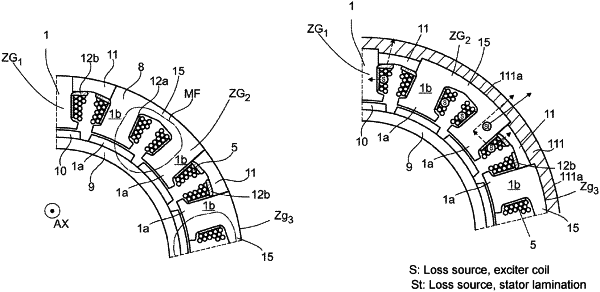| CPC H02K 1/20 (2013.01) [H02K 1/146 (2013.01); H02K 1/278 (2013.01); H02K 1/2791 (2022.01); H02K 9/20 (2013.01); H02K 9/223 (2021.01); H02K 9/227 (2021.01); H02K 11/33 (2016.01); H02K 21/16 (2013.01); H02K 2213/03 (2013.01)] | 29 Claims |

|
1. An external stator of a rotating-field machine with internal rotor, the external stator including:
a number, N, N≥2, stator teeth which together form a number, N/2, of tooth groups, wherein each respective stator tooth has one pole core and one pole shoe integrally formed thereon, wherein the one pole core of the respective stator tooth is manufactured from a first material, wherein each respective one of the N/2 tooth groups is formed by two directly adjacently arranged stator teeth which, together with a magnetic return, are constituent parts of a magnetic circuit, and
at least one intermediate element arranged between two adjacent stator teeth of two adjacent tooth groups, wherein the at least one intermediate element extends in an axial direction of the stator and is manufactured from a second material that differs from the first material, wherein the second material has a density ρ2 which is smaller, at least by a factor of 2, than a density p1 of the first material, and wherein the second material has a heat conductivity λ2 of greater than 100 W/mK.
|